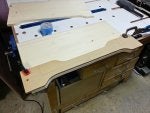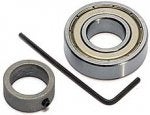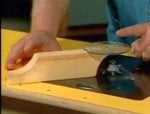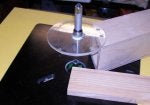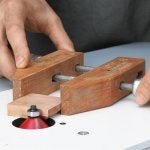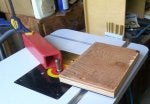I worked in a wood craft production shop way back in 1990 where they had TWO men per router. There was no fence. The bit had a bearing at the top. The wood blocks would be cut out on a bandsaw to achieve the basic shapes, and the "edgers" would put a 3/8" radius on all edges of all pieces using the router tables. The pieces were cut out of 2x6 lumber, so the bearing would hit the piece about 1/2 way up.
One man was on each side of the table. Man #1 would place the wooden shape on the table, edge up to the bit, hit the bearing, and put a radius on one edge of the piece. The moment he pulled it away to position it for the next cut, man #2 would approach the bit from the opposite side and do the same thing.
Each time a man would pull a piece away from the router bit, the other man would immediately put a piece against the bit and route an edge from the other side. This allowed for nearly 90% time efficiency in routing the many THOUSANDS of wooden shapes they would route every day. The bits were almost ALWAYS cutting a radius into the wooden products. The shop had several router tables. It would take a few days for an "E-Team" to learn to work together and get their timing down so the work would not pile up next to their table. Once matched, the E-teams worked together every single day on the same table. If one edger was sick, the other edger would be matched with a pre-selected and tested alternate from another department for the day, or be put on another machine. It was like watching two men drive a circus tent stake into the ground with sledge hammers! I respected those men. Talk about a need to FOCUS!!! The edgers had the most dangerous job in the plant.
Once in a while, an edger would lose his grip. A few fingers went into the router bits in the year I worked there. Stitches were common, and a doctor was always on call nearby. The shop had a big pile of white cloths and an ice machine. Just like my thumb going into the bandsaw blade on occasion, the edgers knew that once in a while, they'd shave off a fingernail or something. It was just part of the job. Most of the injuries were just deep cuts to the finger pads or a lost nail.
I got to where I would know when it happened, just by the sound. First, a sort of rapid click as the bit grabbed the wood, and them a piece of wood would fly across the shop and hit the far wall or something.
The edgers were the next station over from the bandsaws, run by the "shapers." I was a shaper. There were four bandsaws. We got planks of wood from the "stampers" who used curved rubber stamps to roll the patterns onto the planks. I could cut about 450 pieces in a day, but there was a girl there who ALWAYS beat me by a few pieces, no matter how fast I moved. If I did 460, she did 472, etc. We weren't paid by the piece, but after you cut the same shape 8,000 times on a bandsaw, it becomes muscle memory and you just naturally get really fast!
Our pieces would be inspected and sorted (keep/seconds/discard) by the "buyers" (Would you buy this?) They would determine whether the piece was first class, a 'second,' or to be rejected, based on the shape, the edge, and any knots or other undesirable characteristics.
After the shapers cut them, and they were passed to the edgers, the "sanders" would take them, then they went to the "sorters," the "taggers" (paper labels), the "shrinkers" (shrink wrap) and the "Packers" and finally the "shippers." They'd ship them out to the distributors who sent them out to the retail stores.
Our lumber was shipped to us on a railroad flat car. We went through a LOT of wood every week. I'd guess that we were putting out 12,000 pieces per day, from the entire shop. This included shelves and spice racks and doll chairs and clock faces and everything else "WOOD." All that pine stuff you see at Hobby Lobby now ... that is the type of stuff we made. I really did enjoy that job, but I was NEVER an edger!
The rejected pieces and cutoffs were tossed into a 40-foot roll off bin which was emptied almost every day. The dust collection system was simply massive. It could suck the dust and chips out of 100 machines simultaneously.



